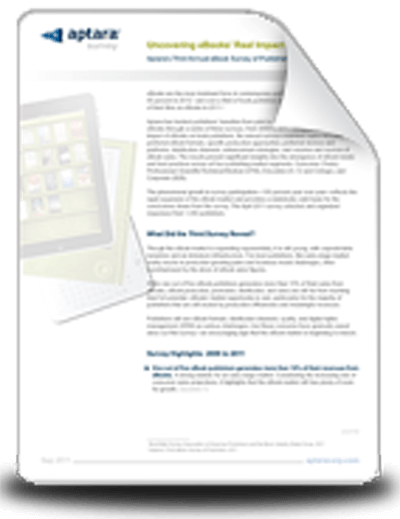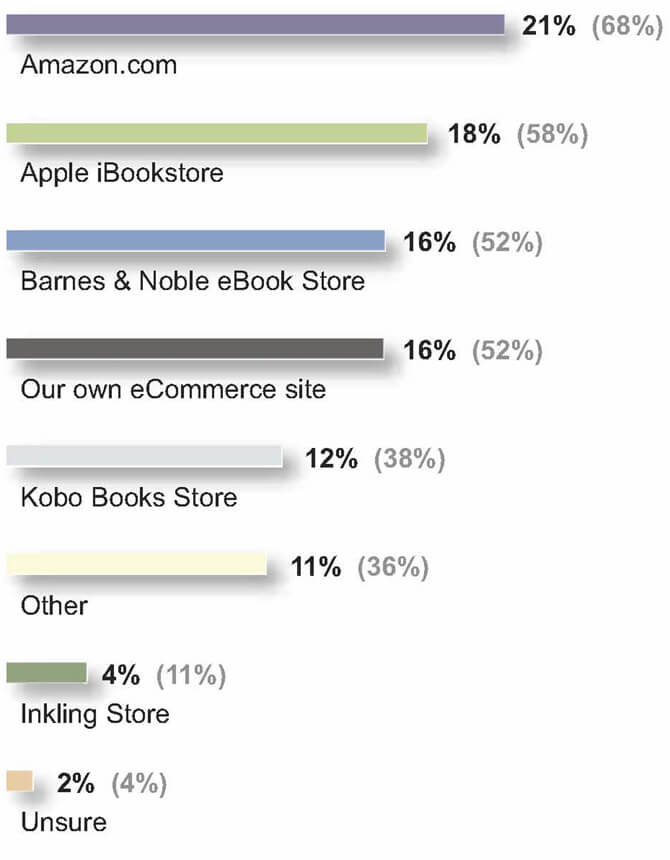 The results of the 4th Annual eBook Production Survey are now available! Sponsored by Publishers Weekly magazine and tech expert Aptara, the survey tracks eBook publishing trends, challenges, and strategies that have emerged since 2009 when the eBook market began taking shape.
The results of the 4th Annual eBook Production Survey are now available! Sponsored by Publishers Weekly magazine and tech expert Aptara, the survey tracks eBook publishing trends, challenges, and strategies that have emerged since 2009 when the eBook market began taking shape.
“As mobile device adoption rises and consumer reading habits change, so does publishing’s competitive landscape,” said Dev Ganesan, Aptara’s President and CEO. “This year’s survey data reveals that while publishers continue to ramp-up production to meet the eBook market demand, they are finally starting to make money in the process.”
“The latest survey results provide valuable market intelligence for all members of the book industry and offer unique insight into the dynamic changes of the last three years,” said Jim Milliot, Co-Editorial Director, Publishers Weekly.
Here are some of the survey’s findings that authors should find interesting:

Publishers were asked: Through which channels are your eBooks distributed? This question allowed for multiple responses. The first %’s have been normalized to add up to 100%. The %s in parentheses show total responses.
- 4 out of 5 publishers now produce eBooks, a remarkable 30% increase in three years.
- The majority of publishers now produce more than 50% of their titles as eBooks.
- Almost half produce more than 75% of their titles as eBooks.
- Amazon.com is the most popular sales channel, used by 68% of eBook publishers.
- Apple’s iBookstore comes in second at 58%.
- Amazon is also the most lucrative eBook sales channel. Publishers’ own websites come in a distant second place for generating the most eBook sales.
- Yet, Apple’s iPad is the preferred eReading device of publishers themselves over Amazon’s Kindle and Kindle Fire tablet combined. 53% of publishers would rather read eBooks on an iPad. (Meaning, you’ll want both editions for your own book!)
- 86% of eBook publishers still produce a print version of every eBook title.
- Four out of five publishers now produce eBooks, a 30% increase in three years and a significant 18% increase in just the last year.
- In last year’s survey, 16% of publishers said they did not foresee producing eBooks in the near future. This year, just 6% have no such plans.
- Trade (92%) and Education/K-12 (91%) publishers are the most “all-in” with eBooks.
- Trade publishers have experienced the most dramatic increase in eBook involvement: from 50% in 2010 to 92% in 2012, including a 16% spike in the last year alone.
- Nearly half of eBook publishers are producing more than 75% of their titles as eBooks—a 22% increase since 2010.
- Digital content now accounts for more than 10% of annual revenues for more than a third of publishers (36%). Since the early days of eBooks, this double-digit threshold has been regarded as the indicator of eBooks’ “arrival”. Even with pricing models still in limbo, publishers are generating significant income from eBooks.
- Amazon has remained the most popular distribution channel for eBooks for two years running. In 2011, 57% of respondents said they sold digital titles through the eTailer.This year the number rose to a significant 68%.
From this brief data it’s easy to see that whether you’re going the traditional route or self-publishing, there’s an eBook in your future! Want to learn more? Download the 4th eBook Survey of Publishers results and analysis to read the entire 41 page report!
About Aptara
Serving 9 of the 10 largest publishers in the world, Aptara is a US-based company founded in 1988 around its unique publishing technical expertise. Our over 5,500 professionals are deployed globally to help content providers create, enrich, publish, monetize, and manage their assets in the digital age.
About Publishers Weekly
Publishers Weekly is the international newsmagazine of the book publishing industry. Founded in 1872 and published continuously since then, the weekly trade magazine publishes six newsletters, including PW Daily and PW Tip Sheet; five blogs; and a robust website. The magazine has also launched a mobile edition, digital editions and an app. Publishers Weekly reviews more than 8,000 books each year, in addition to featuring author interviews and news about bookselling, marketing, merchandising and the publishing trade, along with regular columns on rights, people in publishing and bestsellers. www.publishersweekly.com.

Comments are closed.